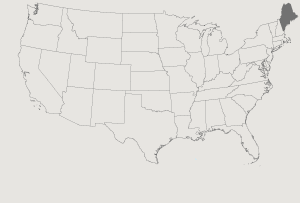Clara Neptune Keezer was born on the Passamaquoddy tribal land of Pleasant Point in Perry, Maine, into a family that had been known for basket making and woodworking for decades. She received little formal instruction, learning instead by watching and emulating older members of her family.
Keezer described for NEA interviewer Mary K. Lee the experience of making her first basket: “I was 8 years old, and I was in Old Town with my grandmother, where she was from. We would go there for the summer sometime. I just wanted to make a little one. Usually there were tourists that came by and wanted to buy baskets. I had this little one almost finished. I made it on a jar, a mustard jar or a mayonnaise jar, I don’t remember just what. But I made that, and I finished it with the help of my grandmother. I sold it for fifty cents, and I was proud.”
As Keezer’s skills grew, she created a variety of baskets, including a number shaped like berries and fruit. First she made a strawberry basket, in response to a request from a customer. “So I looked through some books. I knew what a strawberry looked like, but I just wanted to get the shape of it right. I bought some plastic fruit, and that’s how I got started on the small berries, the strawberries, using the plastic fruit as a mold … blueberry, apple, plum and a corn basket. I worked on all them.” She also created stylized baskets of her own design, including ornamental ears of corn and little bumblebees crafted from split ash. Most difficult, she says, is the pillow-shaped star basket. “You have to be real careful of the measurements. If you make one little mistake, it doesn’t look right, and it’s very hard to take it apart.”
The process is painstaking. Her primary materials are ash and sweet grass. “There’s a lot of work to prepare the ash,” she told Lee. “The men have to pound the ash to get the strips off. Then we have to split it and gauge it — scrape it and gauge it for the fancy baskets we want to make — and that’s really hard work. We usually try to get everything done in one day. That way, we can set it aside and get it whenever we need it. My son picks the sweet grass, and we clean it and put it in small bunches, hang it up to dry. After it’s nice and dry, we wrap it up and put it in a dark place, like a closet or under the bed. It will keep for a long time.”
Keezer has passed her art along to two of her sons and to apprentices, though she said it’s often hard to find people with the patience necessary to master the work. “I enjoy taking these ideas and turning them into beautiful baskets,” Keezer said. “I feel that I am not only passing on an Indian tradition, but if someone takes the time to tell me that my baskets are beautiful, that means everything to me.”


















